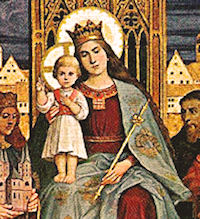Advent: December 17th
Tuesday of the Third Week of Advent; St. Jose Manyanet, priest
Other Commemorations: St. John of Matha, priest (RM); St. Josep Manyanet y Vives, Priest (RM) ; Other Titles: Day 1 O Antiphons: O Sapientia (O Wisdom)
» Enjoy our Liturgical Seasons series of e-books!
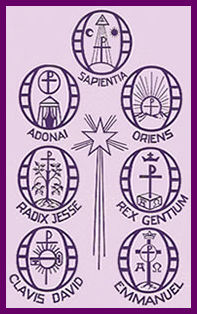 December 17 marks the beginning of the O Antiphons, the seven jewels of our liturgy, dating back to the fourth century, one for each day until Christmas Eve. These antiphons address Christ with seven magnificent Messianic titles, based on the Old Testament prophecies and types of Christ. The Church recalls the variety of the ills of man before the coming of the Redeemer. See O Come! The O Antiphons and Rejoice the Lord is Near! for more information on the O Antiphons by Jennifer Gregory Miller. Build an O Antiphon House with the instructions found here.
December 17 marks the beginning of the O Antiphons, the seven jewels of our liturgy, dating back to the fourth century, one for each day until Christmas Eve. These antiphons address Christ with seven magnificent Messianic titles, based on the Old Testament prophecies and types of Christ. The Church recalls the variety of the ills of man before the coming of the Redeemer. See O Come! The O Antiphons and Rejoice the Lord is Near! for more information on the O Antiphons by Jennifer Gregory Miller. Build an O Antiphon House with the instructions found here.
Today is the feast of Josep Manyanet y Vives who was born to a large and pious family. He was dedicated to Our Lady at age 5 by his mother. Educated by the Piarist Fathers in Barbastro, Spain, and then in seminaries at Lleida and Urgell in Spain. He founded the Congregation of the Sons of the Holy Family in 1864 and the Missionary Daughters of the Holy Family of Nazareth in 1874. Both were dedicated to serving the Christian family, teaching, and parish ministry. He wrote books and pamphlets encouraging devotion to the Holy Family, to help the spiritual formation of the members of his congregations, to help families in trouble, and about school management. He also founded the magazine La Sagrada Familia.
Today, according to the Roman Martyrology, is the feast of St Lazarus known as the brother of St Martha and St Mary of Bethany. He was the man whom Jesus raised from the dead after having been dead and in his tomb for four days. The Bible does not trace his history after the miracle, but tradition says he became a missionary to Gaul, the first bishop of Marseilles, France, and a martyr in the persecutions of Domitian.
Those using the Jesse Tree should continue from today until Christmas by using symbols based on the “O” antiphons (see Jesse Tree Instructions).
![]()
O Wisdom
Divine Wisdom clothes itself in the nature of a man. It conceals itself in the weakness of a child. It chooses for itself infancy, poverty, obedience, subjection, obscurity. "I will destroy the wisdom of the wise and the prudence of the prudent I will reject. . . . Hath not God made foolish the wisdom of this world? For seeing that in the wisdom of God the world by wisdom knew not God, it pleased God, by the foolishness of our preaching, to save them that believe. For both the Jews require signs, and the Greeks seek after wisdom; but we preach Christ crucified, unto the Jews, indeed, a stumbling block, and unto the Gentiles foolishness; but unto them that are called, both Jews and Greeks, Christ, the power of God and the wisdom of God. . . . But the foolish things of the world hath God chosen, that He may confound the wise; and the weak things of the world hath God chosen, that He may confound the strong. And the base things of the world and the things that are contemptible, hath God chosen, and the things that are not, that He might bring to naught the things that are" (I Cor. 1:19 ff.).
- Come, O divine Wisdom, teach us the way of knowledge. We are unwise; we judge and speak according to the vain standards of the world, which is foolishness in the eyes of God.
- Come, O divine Wisdom, give us the true knowledge and the taste for what is eternal and divine. Inspire us with a thirst for God's holy will, help us seek God's guidance and direction, enlighten us in the teachings of the holy gospel, make us submissive to Thy holy Church. Strengthen us in the forgetfulness of self, and help us to resign ourselves to a position of obscurity if that be Thy holy will. Detach our hearts from resurgent pride. Give us wisdom that we may understand that "but one thing is necessary" (Luke 10:42). "For what doth it profit a man if he gain the whole world and suffer the loss of his own soul?" (Matt. 16:26.) The Holy Spirit would have us know that one degree of grace is worth more than all worldly possessions.
—Excerpted from The Light of the World by Benedict Baur, O.S.B.
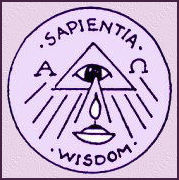
1st O Antiphon:
Symbols: All-Seeing Eye and the Lamp
Come, and teach us the way of prudence.
O Wisdom, who came from the mouth of the Most High, reaching from end to end and ordering all things mightily and sweetly, Come, and teach us the way of prudence.
O Sapientia, quae ex ore Altissimi prodiisti, attingens a fine usque ad finem fortiter, suaviterque disponens omnia: veni ad docendum nos viam prudentiae.
The "all-seeing eye" represents the all-knowing and ever-present God. During the late Renaissance, the eye was pictured in a triangle with rays of light to represent the infinite holiness of the Trinity. The lamp is a symbol of wisdom taken from the parable of the wise and foolish virgins in Matthew 25.
Recommended Readings: Proverbs 8:1-12
![]() Today is Day Two of the Christmas Novena.
Today is Day Two of the Christmas Novena.
St. John of Matha
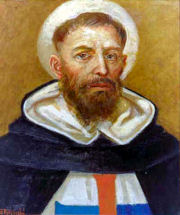 John of Matha, the founder of the Trinitarian Order, was born at Faucon, on the borders of Provence, in France. He was trained as a young noble in horsemanship and the use of arms, decided to study for the priesthood, and was ordained in Paris. After some years in solitude, he conceived the idea of founding an order to ransom Christian captives from the Muslims and went to Rome to obtain the blessing of Pope Innocent III.
John of Matha, the founder of the Trinitarian Order, was born at Faucon, on the borders of Provence, in France. He was trained as a young noble in horsemanship and the use of arms, decided to study for the priesthood, and was ordained in Paris. After some years in solitude, he conceived the idea of founding an order to ransom Christian captives from the Muslims and went to Rome to obtain the blessing of Pope Innocent III.
Houses of the Order were established at Cerfroid and Rome and in Spain. He was very successful in the work of ransoming captives and his order spread. Very little is known for certain about his life, and in the fifteenth and sixteenth centuries, to bolster his reputation, certain members of his order fabricated stories about him, filled his life with miracles and amazing adventures, and connected the beginnings of his order with St. Felix of Valois.
The Trinitarian Order had not preserved any archives of their order and had little knowledge of the life of their founder. Another order, the Order of Mercy, was founded for the same reason as their own, and they compiled a fictitious record of the beginnings of their order. This takes nothing away from the achievements of St. John of Matha, but it does obscure the true story of his life and work.
We do know that he received approval of his order from Pope Innocent III in 1198 and that he died in Rome in 1213. His relics were taken to Madrid in 1655, and he was recognized as a saint in 1694. At his death, there were thirty-five houses of the order throughout Europe. The Trinitarians were one of the first religious orders to combine monastic discipline with pastoral work and one of the first to become international in its work. The order flourishes today in several countries and in 1906 made a foundation in the United States.
—Excerpted from The One Year Book of Saints, Rev. Clifford Stevens
Patronage: Against lightning; against pestilence; archers; automobile drivers; automobilists; bachelors; Baden, Germany; boatmen; bookbinders; Brunswick, Germany; bus drivers; cab drivers; epilepsy; epileptics; floods; fruit dealers; fullers; gardeners; hailstorms; holy death; lightning; lorry drivers; mariners; market carriers; Mecklenburg, Germany; motorists; pestilence; porters; Rab Croatia; sailors; Saint Christopher's Island; Saint Kitts; storms; sudden death; taxi drivers; toothache; Toses, Girona, Catalonia, Spain; transportation; transportation workers; travellers; truck drivers; truckers; watermen.
Symbols and Representation: Branch; giant; torrent; tree; man with Christ on his shoulders.
Highlights and Things to Do:
- Like Mother Teresa of Calcutta, St. John of Matha saw a critical need for the Church at the time and set about doing something about it. He devoted all of his time, his efforts, and his resources to ransom his fellow Christians from slavery, and his work continued into modern times, until slavery was abolished. Like him, we should look around us and see what good has to be done and then courageously put our hand to the task.
- Read a longer biography of St. John.
St. Josep Manyanet y Vives
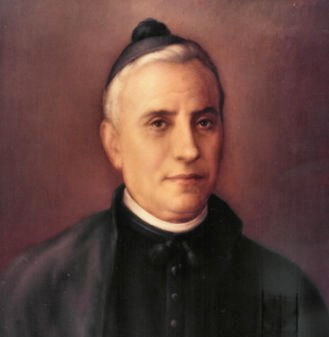 Josep Manyanet was born within a large and Christian family on January 7, 1833 in Northeastern Spain, in the city of Tremp, province of Lleida. He was baptized on the same day at his parish Church of our Lady of Valldeflors, patroness of the city. At a very early age, when he was five years old, he was offered to our Lady by his mother. He had to work to complete his schooling with the Piarist Fathers in Barbastro and at the Seminaries of Lleida and Urgell. He was ordained priest on April 9, 1859.
Josep Manyanet was born within a large and Christian family on January 7, 1833 in Northeastern Spain, in the city of Tremp, province of Lleida. He was baptized on the same day at his parish Church of our Lady of Valldeflors, patroness of the city. At a very early age, when he was five years old, he was offered to our Lady by his mother. He had to work to complete his schooling with the Piarist Fathers in Barbastro and at the Seminaries of Lleida and Urgell. He was ordained priest on April 9, 1859.
After twelve years of hard work in the Diocese of Urgell at the service of his bishop as private secretary, librarian of the seminary, administrator of the chancery and secretary for pastoral Visitations, he felt God's call to become a religious priest and to found two religious congregations.
Founder and Apostle of the Holy Family
With the approval of his bishop, he founded, in 1864, the religious congregations of the Sons of the Holy Family Jesus, Mary and Joseph and, in 1874, the Missionary Daughters of the Holy Family of Nazareth with the mission to honor, imitate and propagate the example of the Holy Family of Nazareth and the Christian formation of families, especially through the catholic education of children and youth and through priestly ministry.
With constant work and prayer, with and exemplary life full of virtues, with loving dedication and solicitude for the souls, he guided and encouraged for almost forty years, the formation and expansion of his Institutes, opening schools and centers of ministry in several towns in Spain. Today both Institutes are present in several European countries, in North and South America and in Africa as well.
Especially called by God to present to the world the example of the Holy Family of Nazareth, he wrote several books and booklets to spread the devotion of the Holy Family. He founded the magazine La Sagrada Familia and promoted the idea of the construction of a Temple dedicated to the Holy Family. The Temple, as yet unfinished in Barcelona, was built by the architectural genius and Servant of God Antonio Gaudí, destined to perpetuate the virtues and examples of the Family of Nazareth and to be the universal spiritual home of all families.
Illnesses and Death
Because of his poor health, due to open sores on his side, which he labelled God's mercies for 16 long years, on the 17th of December of 1901, full of virtues and good deeds, was called by God to his eternal home, in his school “Jesús, María y José” of Barcelona, central place of his work, surrounded by children, with the same simplicity that characterized all his life. His last words were his fervent prayer Jesus, Mary and Joseph, may I breathe forth my soul in peace with you.
Witness to Holiness
His saintly life impressed many people who came in contact with him. The Process of Canonization was formally introduced in 1956. Once the practice of all virtues in a heroic grade was officially recognized by the church in 1982 and proof of a healing miracle attributed to his intercession, Pope John Paul II declared him Blessed in 1984. After the approval of a second miracle through his intercession, Josep was canonized in Rome, on May 16, 2004.
Pope John Paul II has stated that the sanctity demonstrated by Josep Manyanet stems from the Holy Family. He was called by God, so that “in his name every family on earth may be blessed.” The Holy spirit guided him to boldly proclaim the “Gospel of the family”. His inspiration was that “all families may imitate and bless the Holy Family of Nazareth”. That is: “to build a Nazareth in every home”, and to make of every family a “Holy Family”.
His canonization brings forth the truth of his sanctity and the unending value of his message from Nazareth. That makes him a Prophet of the family and the protector of our families.
—Excerpted from the Vatican website
Highlights and Things to Do:
- Read this biography of St. Josep's life.
- Read about the Sons of the Holy Family which St. Josep founded.
- Consider joining the Holy Family Association in which the laity participate in St. Josep's order.
- A version of the life of St. Josep on YouTube in Spanish.
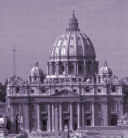 Third Sunday of Advent, Guadete Sunday, Station with San Pietro in Vaticano (St. Peter's in the Vatican):
Third Sunday of Advent, Guadete Sunday, Station with San Pietro in Vaticano (St. Peter's in the Vatican):
The Station is at St. Peter's in the Vatican. After the two great basilicas chosen for the first and for the second Sunday in Advent, we come to St. Peter's in the Vatican, a church which shares with the Lateran the chief feasts of the year. It was selected as the station for today, because on this Sunday occurred the final scrutiny or examination of those candidates preparing for the Ordinations usually held on Ember Saturday in December. The original basilica was built by Constantine in 323 over the place where St. Peter was buried.
St. Peter's Basilica Information
Rome Art Lover
For further information on the Station Churches, see The Stational Church.





